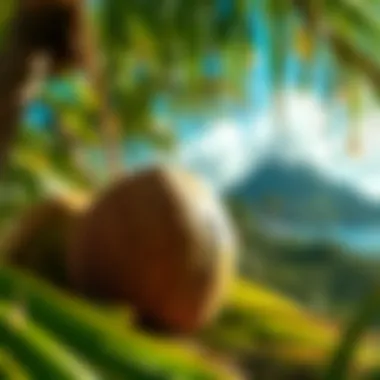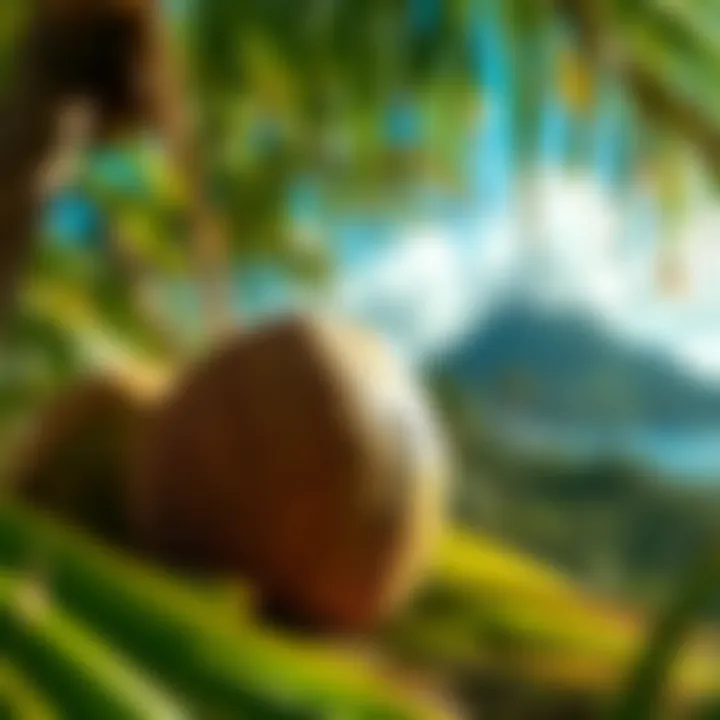Coconut's Cultural and Economic Impact in St. Lucia


Intro
Coconut is much more than just a fruit to the people of St. Lucia; it is a symbol of identity, tradition, and an economic cornerstone for many islanders. The presence of coconut palm trees can be seen swaying gently in the warm Caribbean breeze, their leaves whispering secrets of a culture deeply intertwined with the land. From the mountains to the seas, this versatile fruit has carved out a niche, offering a treasure trove of health benefits, culinary delights, and avenues for revenue.
In this exploration, we delve into the myriad roles that coconut plays in the lives of St. Lucians. By examining local traditions and contemporary practices, we will uncover how this tropical delicacy has woven itself into the fabric of the community. From its historical significance to its current economic impact, we aim to capture the essence of this true island ambassador.
As we journey through the following sections, we invite readers to discover not only the cultural importance of coconut but also its potential for future development in the vibrant landscape of St. Lucia.
Prolusion to Coconut Cultivation in St. Lucia
The coconut, commonly known as the tree of life, plays a pivotal role in St. Lucia's cultural and economic landscape. From the golden sands of its beaches to the sprawling plantations that dot the landscape, the importance of coconut cultivation can hardly be overstated. It isn’t just a fruit; it embodies a way of life for many locals, weaving its way through the fabric of daily existence. For the adventurous spirits—whether kiteboarders enjoying the wind or outdoor instructors leading treks along lush coasts—coconuts symbolize both refreshment and resilience in harsh climates.
Coconut palms thrive in St. Lucia’s warm, tropical climate, which ensures high yields. The nutrient-rich volcanic soil complements this, making the cultivation not only feasible but highly productive. Beyond the beauty of its landscapes, there are also tangible economic benefits, as coconut farming is a source of livelihoods for many families. Employment opportunities in farming, harvesting, and processing coconuts pump money into local economies, benefiting communities that are often overlooked in larger economic discussions.
Coconut farming is intertwined with sustainable practices, as many farmers engage in organic methods that protect the soil and environment. This aspect of cultivation appeals to today's eco-conscious consumers, creating niches in the market that tap into growing demands for organic products.
A closer look at the geography and climate of St. Lucia will unfold the nuances of how these elements interact with coconut cultivation. Understanding the historical context of coconut farming also sets the stage for recognizing the evolution of this vital agricultural practice.
Overview of St. Lucia’s Geography and Climate
St. Lucia's geography is characterized by its mountainous terrain and beautiful coastline. The island is home to volcanic hills and lush valleys that offer a variety of microclimates. These factors contribute exceedingly to coconut cultivation, providing the necessary conditions for these palms to flourish. The average annual temperature hovers around 26 degrees Celsius, supporting growth year-round. Rainfall is ample, primarily falling from June to November, creating a perfect watering schedule for coconut palms.
Key geographical features of St. Lucia include:
- The Pitons: These iconic twin peaks not only provide stunning scenery but are also natural barriers that protect inland farms from harsh winds.
- Coastal Regions: Coconut trees thrive along the sandy shores, where salt spray helps create an ideal environment for growth—not too much water and always plenty of sunshine.
This geographical harmony ensures that coconut farming remains a cornerstone of agricultural practices on the island.
Historical Context of Coconut Farming
Coconut farming in St. Lucia has a rich history that extends back to the colonial era when it was introduced by European settlers. Initially used for its wood and fiber, over time, the culinary and economic benefits of coconuts became apparent. The cultivation of coconuts saw a spike during the 19th century as demand increased for coconut oil and copra, leading to the establishment of large plantations.
In recent years, there has been a shift in focus from large-scale plantations to smaller, family-run farms, reflecting a more sustainable approach. These smallholders are keen on preserving traditional practices while also adapting to modern market demands. Historically, coconut farming has shaped not just the economy but also the cultural identity of St. Lucia, evident in local festivals celebrating harvests and recipes celebrating the versatility of coconut.
This historical journey lays the groundwork for understanding the cultural significance of coconuts and their economic impact today.
"Every coconut has a story, and every palm tells the tale of hard work, resilience, and community spirit in St. Lucia."
In summary, coconut cultivation is a dynamic aspect of St. Lucia's identity. As we delve deeper into its cultural and economic implications, we illuminate how this humble fruit commands respect and reverence in an island paradise.
Cultural Significance of Coconut in St. Lucian Society
Coconut is not merely a fruit for the people of St. Lucia; it is a cornerstone of cultural identity, interwoven into the very fabric of daily life. From age-old traditions to modern usages, the coconut tree serves various needs—from sustenance to crafting materials—and embodies the spirit and legacy of the island. Its role transcends the culinary realm, entering the domains of art, spirituality, and communal life. The versatility of the coconut highlights its deep-rooted significance in St. Lucian society.
Coconut in Traditional Festivals and Rituals
Festivals across St. Lucia often burst with activities that feature coconut in prominent roles. For instance, during the Coconut Festival, celebrated annually, locals gather to honor the humble coconut through food, drink, and performances. Traditional dishes made from coconut, like coconut bake and fresh coconut water, serve both as nourishment and as symbols of hospitality and community.
In rituals, coconut is frequently used in blessings or cleansing ceremonies, believed to carry positive energies and ward off negativity. This belief sees the coconut as a sacred conduit between the earthly and divine realms. During weddings, for example, coocnut palms are often erected to symbolize new life and prosperity for the couple. Such practices reflect an ongoing reverence for this fruit, emphasizing its role as a catalyst for unity and celebration.
- Coconut Water: Consumed during festivals, considered to be a restorative beverage.
- Coconut Bake: A traditional food that embodies the island's heritage.
- Cleansing Rituals: Involved in important life events serving symbolic purposes.
This plethoria of uses signifies that the coconut is less about being just a fruit; rather it encapsulates community spirit and cultural continuity. By participating in these festivals, St. Lucians not only pay homage to their ancestors but also strengthen their communal ties in a rapidly evolving society.


Folklore and Mythology Surrounding Coconut
Coconuts also occupy a storied place in St. Lucian folklore. Many tales revolve around the coconut tree, with its tall trunk and frond-like leaves often seen as a source of wisdom, strength, and endurance. Local legends suggest that the coconut tree was a gift from the gods, bestowed upon the people to ensure their survival. One particular story tells of a great storm that destroyed a village, but the last coconut tree standing acted as a shelter, providing food and safety to the survivors. Such narratives are meant both to entertain and educate, embedding life lessons into the community’s understanding of nature.
In many households, it’s common to share stories about the ‘coconut spirit’, believed to come alive during the harvest. This spirit is thought to guide and protect coconut gatherers, ensuring they harvest wisely while respecting the tree. Folklore like this emphasizes the harmony that St. Lucians have with their environment, focusing on respect and sustenance instead of exploitation.
"Coconut trees stand tall like sentinels of stories, blending tradition with the essence of St. Lucian life."
Ultimately, the cultural significance of coconut in St. Lucia is profound. Through festivals, rituals, and stories, it serves as a testament to the resilience and unity of the island’s people, solidifying their bond to their land and community. Coconuts are not just harvested; they are celebrated, narrated, and cherished across generations.
Culinary Applications of Coconut
Coconut is more than just a tropical fruit; it serves as a profound element in the culinary landscape of St. Lucia. Its rich flavor and versatility make it a staple in both everyday meals and festive gatherings. From sweet to savory, the applications of coconut reflect not only the island’s culinary heritage but also its connection to the land and sea.
Popular Coconut-Based Dishes
Coconut acts as a key ingredient in numerous traditional dishes across St. Lucia. Here are a few favorites:
- Coconut Curry: This dish marries local spices and fresh vegetables with creamy coconut milk, creating a comforting, aromatic experience. It's commonly served with rice or bread.
- Coconut Bake: A beloved staple, coconut bake is a fluffy bread infused with coconut, often enjoyed for breakfast or as a side dish.
- Coconut Fish: Freshly caught fish steamed or grilled with coconut sauce is a classic. The coconut elevates the flavors, giving the dish a rich, tropical taste.
- Coconut Candy: This sweet treat made from grated coconut and sugar brings a hint of nostalgia, often found at local markets.
These dishes reflect the island’s culinary diversity, showcasing how coconut can elevate flavors and textures in both everyday meals and festive events.
Coconut Water: A Hydrating Choice
Coconut water is not just a refreshing drink; it is often hailed as nature's sports drink. Packed with electrolytes, it rehydrates and replenishes. In St. Lucia, you can find vendors slicing open fresh coconuts, offering this hydrating nectar on the spot. It is especially popular among athletes and outdoor enthusiasts who appreciate its natural hydration properties.
- Nutritional Benefits: Coconut water contains potassium, sodium, and magnesium, making it a fantastic option for hydration after intense physical activities.
- Low Calorie: Compared to sugary sodas, coconut water provides a guilt-free drinking option.
This natural beverage not only quenches thirst but also offers a taste of the tropical environment, making it a go-to choice for those under the sun.
Health Benefits of Consuming Coconut Products
The health benefits of coconut go beyond mere hydration. Its rich nutritional profile has made it a popular choice among those seeking healthy dietary options:
- Medium-Chain Fatty Acids: The presence of medium-chain triglycerides (MCTs) in coconut oil can enhance metabolism and promote fat burning.
- Fiber-Rich: Coconut flour, made from dried coconut meat, is high in fiber, contributing to digestive health.
- Antioxidant Properties: Many coconut products contain antioxidants which help combat oxidative stress and support overall wellness.
Research supports these health benefits, making coconut not just a culinary delight but a component of a holistic approach to health.
"Coconut is more than food; it's a lifestyle in St. Lucia, embracing both rich flavors and health benefits."
Economic Impact of Coconut Trade
Coconut trade in St. Lucia shapes not just the economy but the very fabric of daily life for many residents. The island's lush soils and favorable climate create a natural setting where palm trees thrive, allowing for a flourishing industry that contributes significantly to local livelihoods. As a crop that spans beyond mere agriculture, coconuts are interwoven into tourism, manufacturing, and health sectors, making them a valuable asset for the region.
Coconut Harvesting: A Critical Industry
Coconut harvesting in St. Lucia is a task that demands both skill and timing. It’s not just about picking ripe coconuts; it’s about understanding the cycles of nature. Harvesters often climb the tall trees, a skill passed down through generations, showcasing an intimate relationship with the land. This industry provides employment to many families, especially in rural areas, creating an opportunity for economic advancement.
Furthermore, the impact goes beyond immediate jobs; it fosters further economic development by encouraging interdependent sectors such as transportation and local markets for coconut products.
"The coconut palm is the tree of life, sustaining families, communities, and economies."
Export Markets and Opportunities


St. Lucia's coconut products have found their way into various export markets, ranging from oils to textile fibers. The overseas demand is evident, especially for organic coconut oil, which is gaining traction in health and wellness circles. As the global market becomes increasingly concerned with sustainability, St. Lucia is poised to leverage its tropical crop for enhanced exports.
Embracing modernization, local producers have begun to explore international collaborations and niche markets, which opens doors to greater opportunity. Efforts to streamline export processes are gaining momentum as stakeholders recognize the potential benefits of tapping into eco-friendly markets.
Key points:
- Growing global demand for coconut oil.
- Potential for organic certifications can boost profits.
- Collaborations with international brands for exposure.
Cottage Industry Development
The rise of cottage industries around coconuts is an interesting development in St. Lucia’s economic landscape. Small-scale producers craft a variety of products, including crafts, cosmetics, and culinary items, which tap into both local and tourist markets. This not only creates additional income streams for families but also promotes local craftsmanship, ensuring that traditions are maintained and celebrated.
Utilizing coconuts in this way encourages a cycle of sustainability, enabling communities to make use of every part of the fruit. As more entrepreneurs venture into this field, there lies a golden opportunity for job creation and innovation in product development.
Potential Benefits of Cottage Industries:
- Job creation within local communities.
- Promotion of traditional crafts to preserve cultural heritage.
- Diversification of the local economy to reduce dependency on single cash crops.
Sustainable Practices in Coconut Farming
Sustainable practices in coconut farming are essential for ensuring the long-term viability of this significant agricultural sector in St. Lucia. As the global demand for coconut products rises, there is an urgent need to adopt methods that safeguard the environment while boosting local economies. Emphasizing sustainability not only helps preserve the natural ecosystems of St. Lucia but also ensures that future generations can continue to benefit from coconut cultivation.
A key element of sustainable coconut farming is the emphasis on reducing chemical inputs. Farmers are increasingly turning toward organic farming techniques to minimize reliance on synthetic fertilizers and pesticides. This transition does not just improve the quality of the coconuts but also has broader environmental benefits. Healthy soil leads to healthier crops, which in turn supports local wildlife and maintains biodiversity. The use of composting and natural pest deterrents exemplifies the shift towards a more sustainable model of agriculture.
In addition, crop rotation is gaining traction among local farmers. By alternating coconut trees with other crops, farmers can enhance soil fertility, reduce pest and disease cycles, and improve their overall yield. This practice promotes a balanced ecosystem in the fields and helps in managing the health of coconut plants.
Another benefit worth noting is agroforestry—integrating coconut palms with other tree species. This technique offers a range of advantages, from providing shade to the palms (which can boost productivity) to serving as habitat for animals. The ecological richness that comes from agroforestry creates a resilient farming model while allowing farmers to diversify their income sources.
The integration of sustainable practices contributes significantly to the economic stability of coconut growers. By tapping into niche markets that prioritize organic and sustainably-grown products, farmers in St. Lucia can command higher prices for their coconuts. This means increased income and investment into their farms, ensuring sustainability not just for their crops, but for the local communities as well.
"Sustainable coconut farming not only benefits the farm; it enriches the entire community, preserving traditions while paving the way for innovation."
Organic Coconut Farming Techniques
Organic coconut farming techniques are becoming increasingly important in St. Lucia, where farmers are embracing methods that promote environmental health and ensure the sustainability of coconut production. The foundation of organic farming lies in the use of natural inputs and holistic management practices.
Farmers often start with healthy soil that is rich in organic matter. This is achieved through practices such as green manuring and cover cropping. For instance, planting legumes as cover crops improves soil fertility by fixing nitrogen and preventing erosion. These techniques reduce the need for chemical fertilizers, supporting healthier trees and, ultimately, high-quality coconuts.
Furthermore, pest management is approached organically through the use of biological controls. This might involve introducing beneficial insects that prey on coconut pests instead of relying on harmful pesticides. Natural deterrents, made from local plants, are also employed. These methods not only save money but also protect the environment and human health.
Environmental Considerations and Biodiversity
Environmental considerations and biodiversity play a crucial role in the sustainability of coconut farming in St. Lucia. Preserving these elements ensures that farming practices do not degrade the land or the local ecosystem. The tropical climate of St. Lucia is home to a rich array of plants and animal species, and coconut farming can either contribute to or harm this biodiversity.
One effective method to maintain biodiversity is through mixed cropping. Incorporating a variety of plants alongside coconut trees fosters ecological balance and encourages diverse insect and animal life. This diversity can lead to more resilient farming systems, where natural pest control is possible due to the ecosystem's healthy interactions.
Moreover, maintaining natural habitats near coconut farms, such as buffer zones along water bodies, helps prevent soil erosion while providing a sanctuary for wildlife. Farmers are beginning to recognize the importance of these practices not only for their crops but for the overall health of the island's environment.
Challenges Facing Coconut Growers
Coconut cultivation in St. Lucia, while deeply rooted in the island's culture and economy, isn't without its hurdles. As the world changes around us, so too do the challenges that growers face. This section delves into two critical concerns: pests and diseases affecting coconut trees, and the unpredictable nature of market fluctuations. Understanding these challenges is vital not just for the farmers, but for the economic stability of the region and the sustainability of coconut products.
Pests and Diseases Affecting Coconut Trees


Coconut trees, often hailed as the tree of life, are susceptible to a range of pests and diseases that pose significant threats to their health and yield. Some of these pests - such as the coconut beetle and the red palm weevil - can devastate entire plantations if left unchecked. They chew through the trees, ruining the fibrous resources and leading to stunted growth or outright death.
Diseases like lethal yellowing, which affects the coconut palm's tissues, have been an ongoing problem. They slowly kill the trees, leading not only to loss of yield but also a decrease in the local biodiversity that depends on healthy coconut ecosystems.
Farmers often turn to a mix of organic and chemical solutions to manage these threats, but the costs can pile up quickly. For the everyday grower, this sometimes proves a tough nut to crack.
"An ounce of prevention is worth a pound of cure," especially in farming. Regular monitoring and implementing integrated pest management strategies can help mitigate some of these issues.
Market Fluctuations and Economic Stability
The economic landscape for coconut products isn’t exactly a walk in the park. Coconut prices can swing wildly due to various factors, including global demand, shipping costs, and supply chain disruptions. For instance, if there is a bumper crop in another coconut-producing country, prices may plummet. This creates a double whammy effect since the growers often invest heavily into their farms, expecting a stable return.
Farmers may find themselves at the mercy of market forces that can change swiftly and sometimes without warning. Many St. Lucian growers rely on local and export markets alike, so international trade agreements and negotiations become essential in ensuring fair prices.
In addition to fluctuating prices, the rise of substitute products can also undercut coconut growers. With the introduction of alternatives like almond and soy products, the demand for coconut-derived goods may diminish, complicating the efforts of those invested in the industry.
Here are a few factors influencing market stability:
- Global demand for coconut oil and water
- Export tariffs and trade agreements
- The impact of climate change on production yields
Future of Coconut in St. Lucia
As we look toward the horizon, the future of coconut in St. Lucia stands as a beacon of potential and opportunity. The role of this lively fruit might evolve, but its foundation in culture and economy will remain rock solid. St. Lucia, known for its lush landscapes and warm climate, is uniquely suited to harness the full benefits of coconut. As global demand for coconut products swells, there are specific elements that can be pivotal for its future: quality enhancement, diversification of products, and sustainable practices.
Coconut is no longer just seen as a tropical fruit; it's morphing into a multifaceted asset. For instance, the rise in popularity of health-focused diets brings coconut water to the forefront as a favored drink among athletes and health enthusiasts. Its hydration benefits are gaining traction, especially among kiteboarders and outdoor adventurers looking to replenish fluids without the sugary additives commonly found in other beverages. Here, the coconut tree stands tall, bearing fruits that cater to diverse needs—nutrition, rejuvenation, and even beauty products like coconut oil.
Innovations in Coconut-Based Products
Innovation is the lifeblood of industries, and the coconut sector in St. Lucia is ripe for novel ideas. Players in this field are already experimenting with coconut flour and coconut milk, which have been gaining popularity not only in local cuisines but also potentially in international markets. Additionally, there's a budding artisan market producing coconut shell handicrafts—beautiful bowls and jewelry that reflect cultural heritage and sustainable practices.
Moreover, advancements in extraction methods have paved the way for premium coconut oil to become a staple in healthy cooking. New techniques can improve yield while preserving the nutritional quality, leading to greater economic benefits for farmers. Potential partnerships with tech firms could also yield mobile apps for farmers, providing them with real-time data on market demand and fair pricing.
"Diverse products from coconut empower local economies while preserving ecological balance."
Policy Recommendations for Sustainable Growth
For the sustainable growth of coconut farming in St. Lucia, policies need to reflect both the needs of farmers and environmental conservation. One key recommendation is to provide training in sustainable agricultural practices. This can include organic farming methods that not only boost productivity but also protect local biodiversity. Collaboration with environmental organizations can help craft programs that enhance soil health and protect water resources.
Additionally, the government should consider subsidies for farmers who implement sustainable practices. Such incentives can drive a larger shift toward eco-friendly farming, while also ensuring that communities benefit from the coconut economy. Promoting local consumption of coconut products would also strengthen the market, creating a more resilient supply chain amidst external market fluctuations.
In summary, the future of coconut in St. Lucia symbolizes not just agricultural heritage but also economic promise. Through innovative practices and solid policy frameworks, St. Lucia can cultivate a coconut economy that flourishes socially, economically, and environmentally.
Finale: The Enduring Legacy of Coconut in St. Lucia
Coconut, often referred to as the "tree of life," occupies a central place in the identity of St. Lucia. This conclusion reinforces the significant role this versatile fruit has played in various aspects of island life—from cultural expressions to economic stability, and even environmental considerations. The coconut tree's contribution goes far beyond its physical presence, delving into the very fabric of community life, health practices, and local traditions.
Throughout the article, several key elements have been highlighted, underlining the importance of coconut in St. Lucian society. Firstly, the cultural significance of coconut shines through in traditional festivals and rituals where it is used as a symbol of wealth and fertility. The fruits are often woven into the cultural narrative, showcasing its role in folklore that intertwines with the islanders' beliefs and practices.
Furthermore, the culinary applications emphasize coconut as a staple in local diets. Its presence in everyday meals and popular dishes not only reflects its versatility but also promotes health benefits which are increasingly recognized worldwide. The rising trend of health-conscious eating has positioned coconut as a sought-after ingredient, due to its nutritious and hydrating properties.
Economically, the coconut industry stands as a pillar of St. Lucia's agricultural sector. By providing employment and supporting local businesses, it forms a critical economic backbone. Export opportunities further enhance its significance, making it integral to the island’s trade landscape. Yet, the challenges posed by pests and market fluctuations remind us of the delicate balance that must be maintained. Responding to these challenges with sustainable practices is crucial for the industry’s future health and longevity.
Looking ahead, innovation in coconut-based products and policy recommendations targeting sustainable farming practices could shape the future of the coconut industry in St. Lucia. This is a journey that requires both investment in research and community engagement, ensuring that benefits ripple through all levels of society.
In summary, the legacy of coconut in St. Lucia is not just a story of cultivation or consumption; it's an ongoing narrative that intertwines culture, economy, and sustainability. Acknowledging this multifaceted importance is essential for ensuring that future generations continue to benefit from what coconut has to offer. As the island progresses, so too must its relationship with this remarkable fruit, echoing the sentiments that unite the people of St. Lucia in their appreciation for this "tree of life."
"The coconut tree serves as a bridge that connects St. Lucians to their past, present, and future, nourished by tradition and innovation."
For further reading on the cultural significance of coconuts, you can check out Wikipedia on Coconuts or explore Britannica’s coverage. Stay tuned to local resources or forums like Reddit to discover the latest discussions surrounding coconut cultivation and usage.



